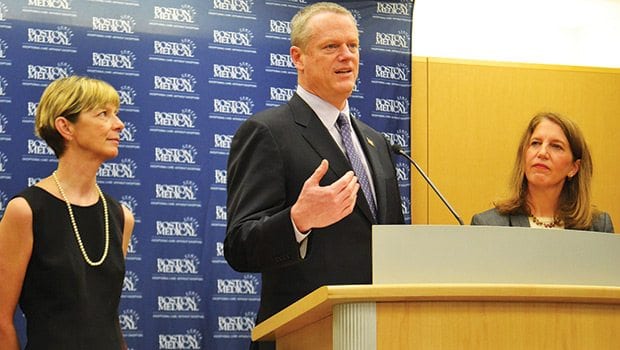Race colors response to opioid crisis
As drugs hit ’burbs, emphasis shifts to treatment programs

It’s no secret that the rapid increase in opioid addiction, overdoses and deaths in Massachusetts is a largely white phenomenon.
But shortly after WCVB channel 5 posted a listing of the top 30 towns hardest hit by overdose deaths, the comments began rolling in. Using data from the Massachusetts Department of Public Health and the U.S. Census, the news broadcaster concluded that the Western Massachusetts town of Ware had the highest per-capita incidence of overdose fatalities.
While many of the readers’ comments bemoaned the flow of opiates into the suburbs, some questioned why Lawrence, the state’s sole majority-Latino municipality, was not even on the list.
“Really? No Lawrence? Something is definitely wrong with this information,” wrote a reader identifying himself as “Mack Dog.”
In fact, the only municipality on the list where whites are not a majority was Brockton, where non-Hispanic whites constitute 42 percent of the population. But in many of the small towns at the top of the list — including Winthrop, Ware, Whitman, West Bridgewater and Ipswich – whites constitute more than 90 percent of the population.
As for cities making the top 30 list, such as Lowell, New Bedford, Fall River, Quincy and Worcester — whites are more than 60 percent of the population.
More heavily-black and Latino cities and towns — including Boston, Springfield, Lawrence and Randolph — didn’t make the list at all.
Historically, at least from the 1960s through the ’90s, heroin addiction was seen as a largely black problem. From Oakland to Harlem to Boston’s South End, the drug flooded into black communities in the early 1970s.
“There was no treatment at all for heroin back then,” notes Bro. Robert Kinney, a former substance abuse counselor who began working with addicts in 1967 at FIRST Academy. “Nothing. There wasn’t any response at all.”
During the ’70s and ’80s, presidents Richard Nixon and Ronald Reagan began and intensified the so-called war on drugs, pouring resources into law enforcement and incarceration.
“They criminalized drug addiction and used the judicial system to handle it,” Kinney said. “The national response to addiction was ‘Just say no.’”
A sickness or a crime?
The United States spent an estimated $51 billion fighting the drug trade nationally and internationally in 2014, according to the Drug Policy Alliance. Investments in treatment, however, have been scant. Going back decades, blacks have argued against the elevation of punishment over treatment.
As far back as the 1940s, renowned jazz singer Billie Holliday argued that heroin addiction was a sickness, not a crime. Famously targeted by Federal Bureau of Narcotics Director Harry Anslinger, Holiday begged a federal judge in 1947 to commit her to a treatment program, rather than prison.
“I want the cure,” she begged the judge.
Instead, she was sent to a West Virginia penitentiary.
Yet famous white addicts were not targeted by federal authorities. Anslinger personally counseled singer/actress Judy Garland to seek treatment for her heroin addiction.
As recently as 2000, similar calls for treatment over incarceration in Massachusetts failed to gain traction. That’s when Ballot Question 8, which would have given judges discretion to assign people convicted of narcotics possession to treatment programs instead of prison. Police officials and district attorneys campaigned vigorously against the measure, which was defeated with public sentiment running 48 percent against and 44 percent in favor, including strong support in the black community.
Shortly after Question 8 was defeated, the tide of public opinion began to shift as low-cost, high-purity heroin from Central and South America began to flood the U.S. market, especially in the suburbs where prescription pain killers already were gaining traction.
Finally in 2010, the Legislature approved a $2 million line item for secure treatment facilities for opioid addiction.
Do all lives matter?
To Kinney, the sea change in support for treatment sends blacks a clear message.
“When we look at the Black Lives Matter movement, people mistakenly think it’s just about police brutality,” he said. “It’s not. It’s about black people recognizing that we’re still treated as second-class citizens in this country. The services we receive reflect that.”
Kinney notes that while millions in public funds have gone into treatment beds for opioid addiction, now so predominant in the white community, people addicted to crack cocaine are not able to receive treatment.
“You can’t get into detox based on cocaine addiction,” he said.
Part of the problem is that overdoses, and resulting fatalities, are more characteristic of opiates than cocaine and other drugs. There were more than 70 overdose-related deaths in each of the first three months of the year, according to state police data, which doesn’t include Boston, Worcester or Springfield. While deaths from cocaine and other drugs are more rare, the addiction is just as difficult to overcome as with heroin, Kinney argues.
“The psychological response to cocaine withdrawal is just as bad or worse than with heroin,” he said. “We have nowhere near the infrastructure we need to treat the level of addiction we have in urban areas.”
State Rep. Gloria Fox, a longtime champion of human services in the State House, said communities of color and advocates for suburban communities are working together to increase services for everyone.
“We shouldn’t be fighting each other for crumbs,” she said. “We have to be specific about what we want. We need more beds. More treatment programs. We need to make sure we’re meeting with the governor, the House speaker and the Senate president and to make sure our priorities are funded.”






